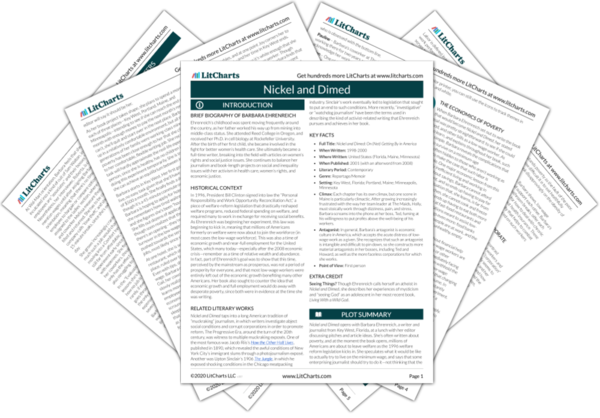Nickel and Dimed makes an explicit contrast between the experience of individual workers and the corporations for which they work. Indeed, the “corporation” is portrayed as a shadowy, distant entity that initially seems to have little impact on the daily working life of Barbara and her colleagues. However, Barbara soon comes to understand how much of low-wage work is dictated by both the needs and the rhetoric of corporations. Corporate rules are, in some cases, tied to the culture of surveillance and suspicion that is also linked to shame. At Jerry’s, the Key West restaurant, headquarters decides to reduce break time to squeeze out more productivity from the staff. And at Wal-Mart, employees are constantly warned against “time theft,” or spending any time chatting or otherwise failing to make money for the company—which in the employers’ view is a dire crime. For the corporation, Barbara argues, profits are what ultimately matters, and workers are little more than drones rather than human beings, meant to work in pursuit of profits.
Nevertheless, the corporations for which Barbara works also employ a whole language and rhetoric around how they support and enrich individual workers’ experiences. Videos produced by Wal-Mart and The Maids are meant to make workers develop a sense of loyalty and belonging to the corporation, while still stressing the possibilities of individual growth. Barbara shows how effective this marketing can be as she describes the guilt of her coworkers at the possibility of failing to achieve their employers’ standards. But she argues that corporate rhetoric is deeply disingenuous, no more than a myth that hides how little corporations care for individual development. Instead, this rhetoric serves to strengthen a system in which corporations benefit far more than the individuals they employ.
Individuals and Corporate Rhetoric ThemeTracker

Individuals and Corporate Rhetoric Quotes in Nickel and Dimed
Cooks want to prepare tasty meals, servers want to serve them graciously, but managers are there for only one reason—to make sure that money is made for some theoretical entity, the corporation, which exists far away in Chicago or New York, if a corporation can be said to have a physical existence at all.
The hands-and-knees approach is a definite selling point for corporate cleaning services like The Maids. […] A mop and a full bucket of hot soapy water would not only get a floor cleaner but would be a lot more dignified for the person who does the cleaning. But it is this primal posture of submission—and of what is ultimately anal accessibility—that seems to gratify the consumers of maid services.
There’s no intermediate point in the process in which you confront the potential employer as a free agent, entitled to cut her own deal. The intercalation of the drug test between application and hiring tilts the playing field even further, establishing that you, and not the employer, are the one who has something to prove. Even in the tightest labor market—and it doesn’t get any tighter than Minneapolis, where I would probably have been welcome to apply at any commercial establishment I entered—the person who has precious labor to sell can be made to feel one down, way down, like a supplicant with her hand stretched out.
But now I know something else. In orientation, we learned that the store’s success depends entirely on us, the associate; in fact, our bright blue vests bear the statement “At Wal-Mart, our people make the difference.” Underneath those vests, though, there are real-life charity cases, maybe even shelter dwellers.
Alyssa looks crushed, and I tell her, when Howard’s out of sight, that there’s something wrong when you’re not paid enough to buy a Wal-Mart shirt, a clearanced Wal-Mart shirt with a stain on it.
The money taboo is one thing that employers can always count on. I suspect that this “taboo” operates most effectively among the lowest-paid people, because, in a society that endlessly celebrates its dot-com billionaires and centimillionaire athletes, $7 or even $10 an hour can feel like a mark of innate inferiority.
My guess is that the indignities imposed on so many low-wage workers—the drug tests, the constant surveillance, being “reamed out” by managers—are part of what keeps wages low. If you’re made to feel unworthy enough, you may come to think that what you’re paid is what you’re actually worth.











